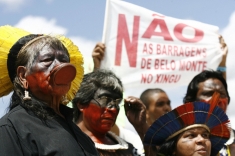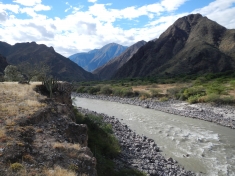New Large Dams in Amazon Could Lead to Ecosystem Collapse
The Amazon Basin is being transformed into a global economic frontier by intense global demand for commodities and energy, which is fueling rapid expansion of monocultures for grains and biofuels, large-scale hydroelectric dams, industrial mining activities and petroleum and gas development. One of the most significant changes in this wave of Amazonian frontier expansion is the growing importance of mega-development projects currently planned or under construction at a pan-Amazonian scale. The magnitude of the socio-environmental impacts caused by these projects is of a qualitatively higher order than those of prior waves of frontier expansion due to the size and geographical range of the projects, the large number of them under simultaneous construction, and the enormous amount of capital invested in them.
The first decade of the 21st century experienced a major restructuring of the financing of development projects in Amazonia. Brazil and China forged new national development strategies based on the policies of the globalization of national companies and the establishment of regional hegemonic spaces dominated by their national capital investments. The Brazilian National Economic and Social Development Bank (BNDES) and the Chinese Development Bank grew rapidly in this period and became the largest investors and creditors of mega-development projects in Amazonia.
The electricity sector
The rapid expansion of the Brazilian economy has generated a growing internal demand for electricity, which in turn has stimulated the Brazilian government to embark on an ambitious program of building hydroelectric dams throughout Amazonia, heavily financed by BNDES. In November 2012, BNDES gave a 30-year, US$11.25 billion loan – its largest ever – to the Norte Energía S.A. Consortium to finance the construction of the massive Belo Monte Dam on the Xingu River. Just a few years earlier, BNDES gave out loans for the construction of two large dams on the Madeira River: $3 billion for the Santo Antonio Dam and $4.75 billion for the Jirau Dam. BNDES also has a growing portfolio of dams it plans to finance in Argentina, Bolivia, Ecuador, Guyana, Paraguay, Peru and Venezuela.
The Andean countries have also adopted a strategy to increase the generation of hydroelectricity, which has gained the interest of foreign investors, particularly from Brazil and China. A recent study identified 151 proposals for the construction of hydro dams in the Andean countries, a 300% increase over its 48 existing dams. More than half of these proposed dams are located in the Marañón River Basin. In all, a total of 17 mega-dams with a generating capacity of over 1,500 megawatts each are currently proposed for Amazonia.
The Peru-Brazil Energy Agreement, signed by the two presidents in 2010, projects the production of up to 7,000 megawatts of hydroelectricity in the Peruvian Amazon for export to Brazil, with a portion to be reserved for Peruvian consumption. This agreement has not yet been ratified by the respective national congresses, nor has it received widespread public input or consent from Amazonian peoples.
Underlying this new wave of dam building lays the strategy of transforming the rivers of the Amazon into industrial factories for the production of electricity for metropolitan areas and large-scale economic projects. The engineering logic requires control of the flow of water in a river from its source to its mouth through the construction of numerous dams along its course. With this control, the energy companies which operate the dams will be able to adjust the flow of the river to the water capacity needs of different dams along the river, with this capacity being bought and sold between companies, thus transforming river flow into a commodity.
Summary of Impacts
Hydrological: One of the most dramatic impacts of large-scale dams in the Amazon stems from the major disruptions in the unique hydrological and biological characteristics of large, free-flowing tropical forest rivers. The blockage of long-distance fish migrations and the destruction of spawning habitats by dams could produce major biodiversity loss, as well as harm riverine fishing communities that depend upon the river for their sustenance.
The construction of many large-scale dams in the vast headwaters region of the Amazon Basin – encompassing parts of Bolivia, Peru, Ecuador and Colombia – will produce critical changes in continental water flows, with little knowledge of the ecological consequences of this policy. When these changes are combined with the continuing environmental events in the Basin related to global climate change, one can postulate that this new wave of dam building in the headwaters of the Basin represents a “continent-wide hydrological experiment” with the subsequent risk of provoking major ecosystem collapse. Recent studies of the phenomena known as “Amazon dieback” warn of the potential for a significant decline in biomass (carbon) of the tropical forest and its subsequent transition to savannah. Other researchers have calculated that the disruption of flooding cycles and sediment deposits by the dams will cause a drying out of numerous wetland forests downriver, both temporarily and permanently, causing deforestation by dehydration.
Social: For the many Amazonian peoples who maintain sustainable, low-impact adaptive practices – indigenous peoples, fishing communities, rubber tappers and others – rivers are essential to their very existence as a people or community. The most directly impacted communities are those forcibly relocated to other lands due to the flooding of their homes and the fertile floodplains by reservoirs. Large-scale dams also provoke downriver impacts, such as drying out of portions of the river, reduction in fisheries and interruption of seasonal floods which fertilize the floodplain; upriver impacts, such as flooding, disruption of fish migrations and sediment flows; and reservoir impacts, such as changes to water quality, and an increase in the release of climate-damaging methane gases. By interrupting the use of the river as a transportation waterway, dams also sever social ties between families and communities located along the rivers.
Networks of resistance and activism
In general, there is a lack of transparency in decision-making about dam building in the Amazon: most dams are approved by politicians and bankers with little or no public input. For many Amazonian communities, by the time they first hear of a hydroelectric project that will greatly impact their lives, the major decisions regarding its construction have already been made.
Social and legal mobilization:Indigenous peoples from across the Amazon Basin have been at the forefront of numerous social mobilizations that have contested the policies of the construction of major development projects in their lands and rivers. Peru’s National March for the Right to Water, the Ecuadorian Indigenous People’s March for Water, Land and Dignity, and Bolivia’s March in Defense of the Isiboro-Sécure Indigenous Territory and National Park are just three examples from recent years. Another tactic of resistance to dam building is international campaigns designed to support indigenous peoples in their effort to stop the building of dams in their rivers, notably the Belo Monte Dam on the Xingu River. Meanwhile, a group of Brazilians filed and won a petition from the Inter-American Commission on Human Rights to force the Belo Monte project to conduct adequate prior consultation with indigenous peoples. Yet, after a forceful rejection of the Commission’s ruling by the Brazilian government, the Commission backtracked and the construction of the dam proceeded.

Labor issues: The construction of massive hydroelectric dams in the middle of the rainforest requires importing thousands of migrant laborers into the enclaves where the dams are built. The working and living conditions in these enclaves tend to be precarious. Since most of the workers are temporary and non-local, they do not have strong union ties nor a capacity to conduct a successful strike. However, the experiences of the first three large Brazilian Amazonian dams in the current wave of dam building – Santo Antonio, Jirau and Belo Monte – reveal how difficult it is to completely suppress these demands. In 2010, for example, workers at the Jirau enclave revolted, burning buses and destroying buildings to protest bad conditions and low pay. The response of the energy company was swift: it expelled all 22,000 workers from its enclave for three weeks, leaving them to fend for themselves far from their homes. Meanwhile, the Belo Monte Dam has suffered nine work stoppages, of varying lengths of time, during the first two years of its construction. This is in addition to 18 external occupations of the work site by indigenous peoples and environmentalists. Unfortunately, the demands by the workers are rarely aligned with the demands of indigenous peoples and environmentalists, even though they are pressuring the same set of energy companies.
Social and environmental safeguards: While regional and global financial institutions such as the Inter-American Development Bank and the World Bank operate according to an established set of safeguard principles, the Brazilian and Chinese national development banks are entering the field of international finance with few of these safeguards in place. During the past two years, several civil society activist networks have targeted these banks via campaigns designed to guarantee that they conduct adequate prior consultations with indigenous peoples; respect their basic territorial rights; mitigate environmental impacts, and compensate for irreversible damage. To ensure that an adequate system of safeguards is established, environmentalists propose the assessment of cumulative, long-term impacts of multiple projects – dams, roads, oil and gas development, industrial mining projects – slated for construction within a watershed framework.
A better path
Putting the entire hydrological functioning of the Amazon Basin under a single, productivist logic will serve to limit and, in some cases, eliminate the multiple uses and functions that rivers have for Amazonian peoples: fishing, cooking, floodplain agriculture, hygiene, transport, recreation, identity. An alternative model for hydrological planning in the Amazon uses “watersheds” as the basic environmental unit of analysis and policy. The nested quality of watersheds allows for political action and policy formulation at differing scales, ranging from small watersheds to major tributaries and, finally, the entire Amazon watershed.
An integrated watershed management approach is founded upon the multiple, interdependent social uses of the river; as such, it proposes that policy decisions regarding river use be discussed in public forums. Across the Amazon Basin, indigenous peoples, along with a host of local Amazonian communities and their allies in civil society, are demanding that the energy policies of their governments be redesigned in order to guarantee the sustainability of their livelihoods. In the process they are building a movement that is also attempting to develop a new model of development that accommodates the specific needs of their rainforest communities. If they are not successful in these efforts, these vibrant rivers and the tropical rainforests that depend upon them may enter into a cycle of ecosystem collapse that will not only destroy the rainforest, but their lives as forest peoples as well.
Paul E. Little is an environmental anthropologist. He has been involved in Amazonian research and policy formulation for the past 25 years. He recently published (in Spanish) a policy paper on mega-development projects in the Amazon, upon which much of this article is based.



